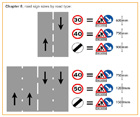
 The Traffic Signs Manual is a comprehensive publication from the Department for Transport (DfT).
There are eight chapters in total, each of which details a specific Traffic sign topic;
Chapter 8 deals with road works and temporary situations and is in two parts:
The Traffic Signs Manual is a comprehensive publication from the Department for Transport (DfT).
There are eight chapters in total, each of which details a specific Traffic sign topic;
Chapter 8 deals with road works and temporary situations and is in two parts:
 At over 550 pages long, Chapter 8 is a very through reference document and therefore very much targeted at those
with a solid understanding of traffic management principles. A less intimidating (100 pages only),
simple-to-follow summary of Chapter 8 can be found in the DfT's Safety at Street Works and Road WorksCode of Practice
- widely referred to as the 'Red Book'.
At over 550 pages long, Chapter 8 is a very through reference document and therefore very much targeted at those
with a solid understanding of traffic management principles. A less intimidating (100 pages only),
simple-to-follow summary of Chapter 8 can be found in the DfT's Safety at Street Works and Road WorksCode of Practice
- widely referred to as the 'Red Book'.
 Although Chapter 8 has no statutory force, it is strongly recommended by the DfT that compliance with Chapter 8
is enforced by Local Authorities and any other organisations responsible for public roads. Consequently,
compliance with Chapter 8 is invariably deemed a condition of contract.
Although Chapter 8 has no statutory force, it is strongly recommended by the DfT that compliance with Chapter 8
is enforced by Local Authorities and any other organisations responsible for public roads. Consequently,
compliance with Chapter 8 is invariably deemed a condition of contract.

Whilst the red book is an unambiguous summary of Chapter 8, there is however one very important detail on which the two documents differ;
Consider: An unrestricted single carriageway will invariably be a rural road and consequently sight lines of the road ahead will be obstructed by bends in the road, hills & valleys.
In addition it is likely that such a road will not have any streetlights or any provisions for pedestrians.
Conclusion: A 900mm sign is significantly more visible than a 750mm equivalent - particularly at night, or in low-light conditions - which is vitally important given the increased vehicle speeds on unrestricted roads, and thus provides the greater protection to workers, motorists and pedestrians alike.